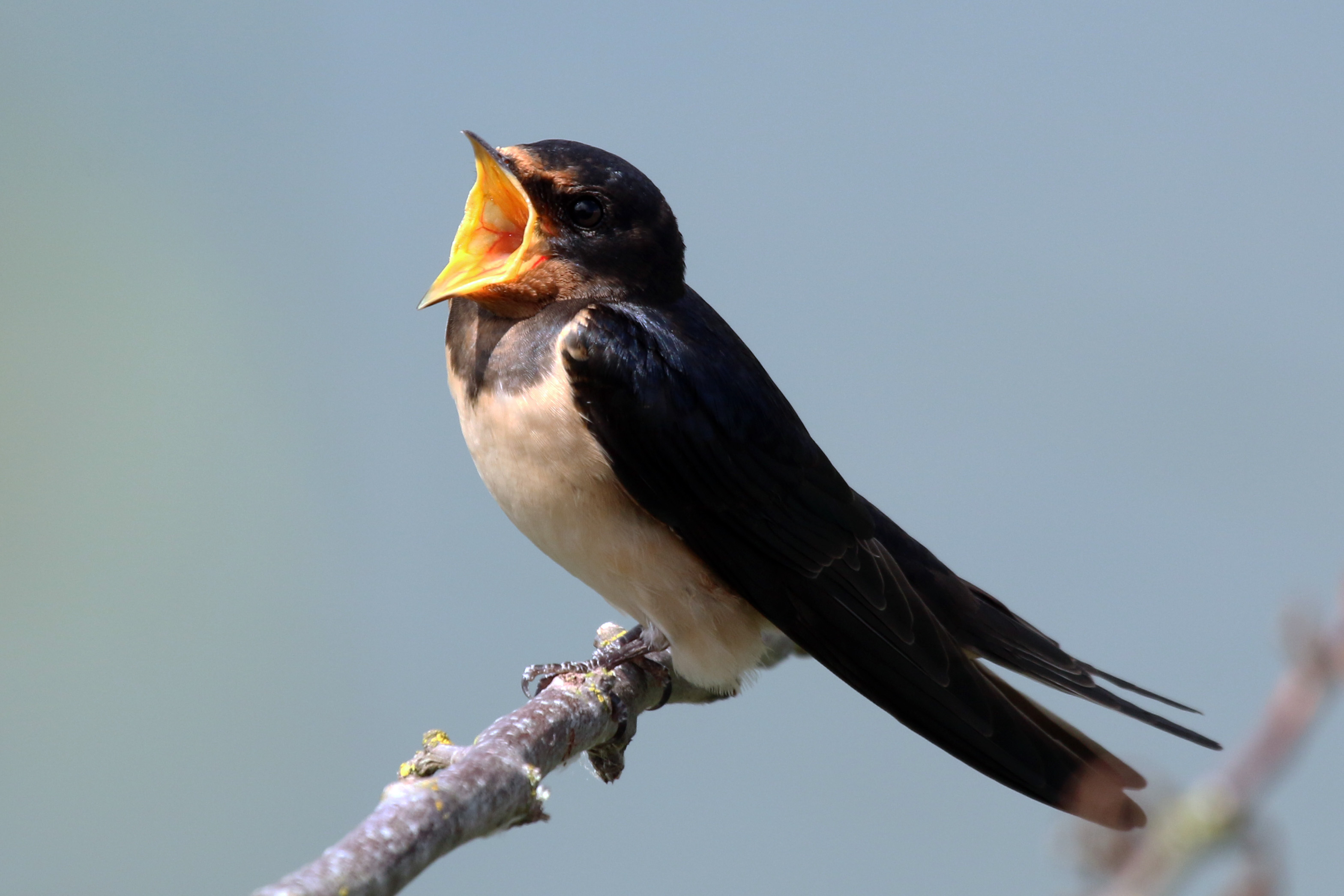Barn swallow
(Hirundo rustica)

Description
Hirundo rustica, commonly known as the Barn Swallow, is a species of passerine bird in the family Hirundinidae. Barn Swallows are known for their beautiful, streamlined bodies and long tail feathers, which make them one of the most graceful and aerodynamic birds in the sky. In this article, we will discuss everything you need to know about the Hirundo rustica, including its appearance, behavior, habitat, diet, and reproduction. Appearance Barn Swallows have a distinctive and recognizable appearance. They are small birds, measuring about 17 cm in length and weighing about 20 g. They have a beautiful blue-black plumage on their backs, wings, and head, with a rust-colored throat and forehead. Their underparts are white, and they have a long, forked tail that is characteristic of all swallows. Barn Swallows also have long and pointed wings that are well-suited to their acrobatic aerial displays and their ability to catch insects in mid-air. They have small, dark eyes and a small, sharp beak that is adapted to catching insects in flight. Overall, their streamlined and aerodynamic bodies make them one of the most graceful and agile birds in the sky. Behavior Barn Swallows are highly social birds and have interesting behavior patterns. Here are some key behaviors of Barn Swallows: Social Behavior: Barn Swallows often nest in large colonies and are highly social birds. They communicate with each other through high-pitched and musical calls. Aerial Displays: During the breeding season, male Barn Swallows will perform elaborate aerial displays to attract mates. They will fly in circles, dive, and swoop through the air, showing off their agility and speed. Migratory Behavior: Barn Swallows are migratory birds and spend their summers in the Northern Hemisphere and their winters in the Southern Hemisphere. Nesting Behavior: Barn Swallows are known for their affinity for man-made structures, such as barns, sheds, and other outbuildings. They will often build their nests on rafters and beams inside these structures, where they are protected from predators and the elements. Female Barn Swallows will build their nests using mud and straw. Feeding Behavior: Barn Swallows are insectivores, and they feed on a variety of flying insects, including flies, mosquitoes, and other small insects. They catch insects in mid-air, using their exceptional flying ability. Hirundo rustica are fascinating birds with unique and interesting behaviors. Habitat Barn Swallows are found in a variety of habitats, from open fields and meadows to urban areas. However, they are most commonly associated with open areas near water, such as marshes, lakes, and rivers. They are also often found in agricultural areas, such as farms, where they feed on insects attracted to crops and livestock. Barn Swallows are known for their affinity for man-made structures, and they often build their nests on beams and rafters inside barns, sheds, and other outbuildings. They are also known to nest in caves and on cliffs near bodies of water. In general, Barn Swallows require open spaces for foraging and areas with vertical structures for nesting. They are adaptable birds and can often be found in a variety of habitats as long as these requirements are met. However, habitat loss and degradation, particularly in areas near water, can pose a threat to Barn Swallow populations. Diet Barn Swallows are insectivores, meaning that they feed exclusively on insects. They have a varied diet that includes a wide range of flying insects, such as flies, mosquitoes, moths, and beetles. Barn Swallows catch their prey while in flight, using their exceptional flying ability to swoop and dive through the air. They are particularly skilled at catching insects in mid-air, and they can catch thousands of insects in a single day. During the breeding season, Barn Swallows will feed their young a diet of small insects, such as gnats and midges, which they collect in their bills while in flight. They will make frequent trips back and forth from their nests to collect food for their young, which can consume up to 400 insects per day. The diet of Hirundo rustica is an important part of their ecology and plays a key role in their survival and reproduction. Reproduction Barn Swallows breed during the summer months, usually between April and September. They are monogamous birds, meaning they mate with one partner for life. During the breeding season, male Barn Swallows will perform elaborate aerial displays to attract females. Female Barn Swallows will build their nests using mud and straw, often attaching them to the rafters and beams inside barns and other outbuildings. They will lay a clutch of 4-5 eggs, which will hatch after about 14-18 days. The young will fledge after about 20-25 days, at which point they will leave the nest and begin to fly. Threats and Conservation The conservation status of Barn Swallows is classified as "Least Concern" by the International Union for Conservation of Nature (IUCN). This classification means that Barn Swallows are currently not considered to be at significant risk of extinction. However, Barn Swallows face several threats to their populations. Habitat loss and degradation, particularly in areas near water, can impact their ability to forage and breed successfully. Pesticide use can also reduce their food supply and have negative impacts on their health. Climate change can also impact the timing of insect emergence, which can affect the timing of breeding and migration for Barn Swallows. Despite these threats, Barn Swallow populations remain stable or even increasing in some areas. This is partly due to their adaptability and ability to use man-made structures for nesting. Conservation efforts to protect and restore wetland and agricultural habitats can also benefit Barn Swallow populations. While Hirundo rustica are not currently considered to be at significant risk of extinction, continued monitoring and conservation efforts are important to ensure their populations remain healthy and stable in the future.
Taxonomic tree:







